The tallest peaks in Nepal are celebrated for their captivating beauty and reverence. At an astounding height of 8,848.86 meters, Mount Everest superciliously holds the world's highest mountain title, but it isn't a one-hit-wonder. Nepal is not just about Mount Everest; it is home to the eight highest peaks in the world, rising above 8000 meters.
Although Everest tends to capture all the attention, other towering peaks like Kanchenjunga, Lhotse, and Makalu are equally impressive. It is a mountain unlike any other, and being the world's third-highest and Nepal's second-highest peak, Kanchenjunga has earned and deserves such status. It is important to recognize and honor mountain peaks ranked third, fourth, fifth, and higher in elevation.
Beyond rock, ice, and snow, these mountains tell tales of tenacity in the face of great adversity, victories, and setbacks. They don't care about climbers and aren't impacted by their achievements or shortcomings. Long after we are gone, these majestic peaks will still stand, awaiting those brave enough to scale them, having been monumental long before our existence.
Let's now explore list of Nepal's ten highest mountains. Each relates a fantastic tale of nature's wonders and people's tenacity.
Top 10 Highest Mountains in Nepal: Name of Mountain in Nepal
|
S. N |
Mountain Name |
Elevation (m) |
Elevation (ft) |
Himalayan Range/Section |
World Rank |
Nepal Rank |
|
1 |
Mount Everest |
8,848.86 |
29,032 |
Khumbu Mahalangur |
1 |
1 |
|
2 |
Kanchenjunga |
8,586 |
28,169 |
Northern Kanchenjunga |
3 |
2 |
|
3 |
Lhotse |
8,516 |
27,940 |
Everest Group |
4 |
3 |
|
4 |
Makalu |
8,481 |
27,824 |
Makalu Mahalangur |
5 |
4 |
|
5 |
Cho Oyu |
8,188 |
26,864 |
Khumbu Mahalangur |
6 |
5 |
|
6 |
Dhaulagiri I |
8,167 |
26,795 |
Dhaulagiri |
7 |
6 |
|
7 |
Manaslu |
8,163 |
26,781 |
Mansiri |
8 |
7 |
|
8 |
Annapurna I |
8,091 |
26,545 |
Annapurna |
10 |
8 |
|
9 |
Gyachung Kang |
7,952 |
26,089 |
Khumbu Mahalangur |
15 |
9 |
|
10 |
Annapurna II |
7,937 |
26,040 |
Annapurna |
16 |
10 |
The top ten list of highest mountains in Nepal are listed below, arranged in ascending order of elevation.
- Mount Everest: Mount Everest has an elevation of 8848.86 meters (29032 feet) and is beautifully situated in the Khumbu region of the Mahalangur range. It holds the first ranking both in Nepal and the world.
- Kanchenjunga: The Kanchenjunga, at an elevation of 8,586 m (28,169 ft), is located in the Northern Kanchenjunga range. It is ranked third globally and second among Nepal's highest peaks.
- Lhotse: A member of the Everest Group, elevation 8516 m (27940 ft). It ranks third in Nepal and fourth worldwide.
- Makalu: Makalu is a mountain in the Makalu Mahalangur range with an elevation of 8481 meters (27824 feet). In Nepal, it is ranked fourth, and globally, it is ranked fifth.
- Cho-Oyu: The Cho-Oyu of the Khumbu Mahalangur range is 8188 meters (26864 feet) above sea level. It is ranked sixth in the world and fifth in Nepal.
- Dhaulagiri: In the Dhaulagiri range, Dhaulagiri I is 8167 meters (26795 feet) above sea level. It is the sixth-ranked mountain in Nepal and the seventh-ranked mountain globally.
- Manaslu: In the Mansiri range at an elevation of 8163 meters (26781 feet), Manaslu is ranked eighth in the world and seventh in Nepal.
- Annapurna I: Located in the Annapurna range, Annapurna I has an elevation of 8091 meters (26545 feet). Among Nepal's Himalayan mountains, it is ranked eighth and tenth overall.
- Gyachung Kang: Gyachung Kang is a mountain in the Khumbu Mahalangur range with an elevation of 7952 meters (26089 feet). It is ranked ninth among the hills of Nepal and fifteenth in the world.
- Annapurna II: With an elevation of 7937 meters (26040 feet), Annapurna II is part of the Annapurna range. It is the second-highest peak in the Annapurna massif, the tenth-highest in Nepal, and the sixteenth-highest in the world.
Mount Everest (8,848.86 meters)- The Roof of the World
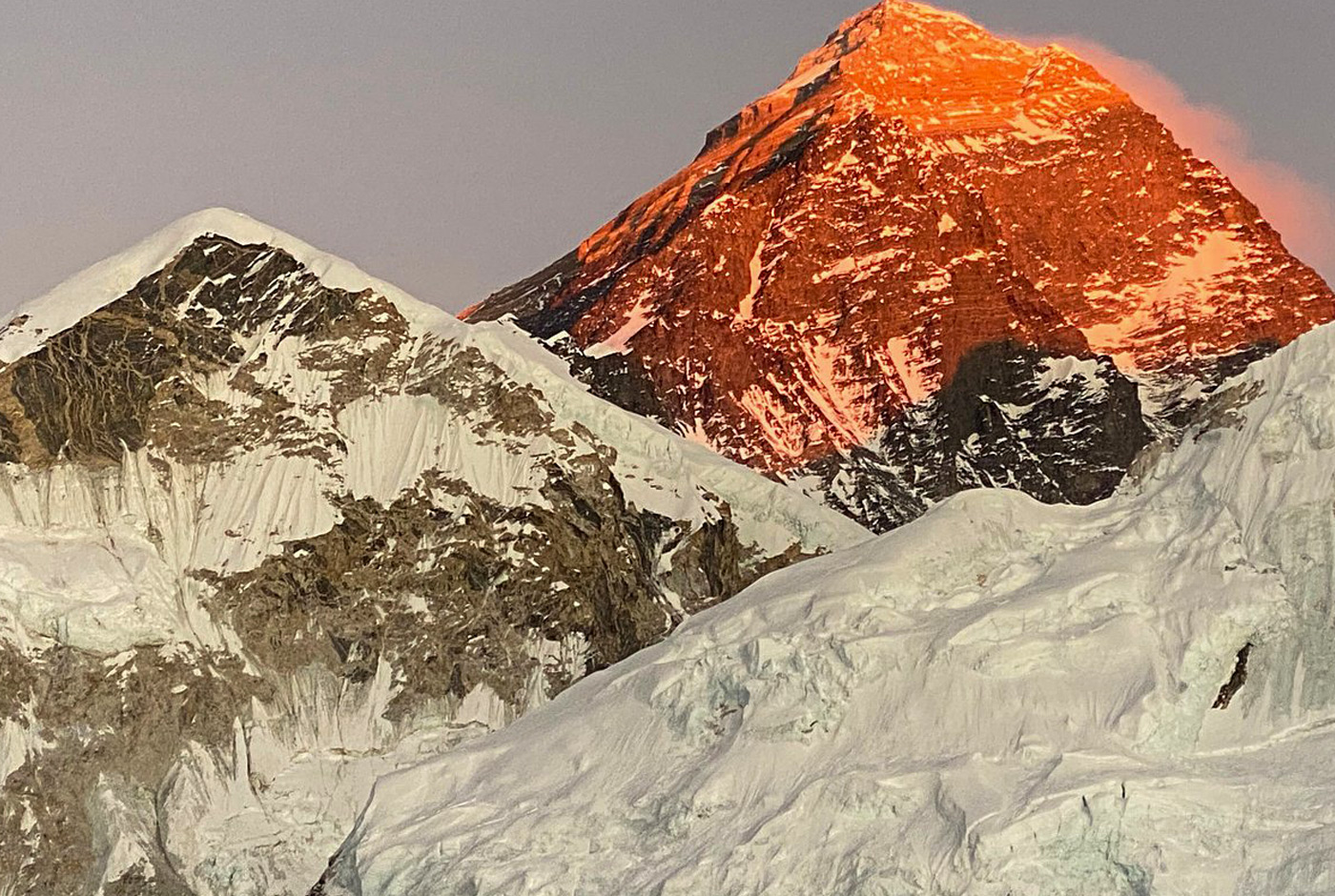
Mount Everest, the world's highest peak at 8848.86 meters, represents the spirit of adventure and humanity. This magnificent mountain has long inspired adventurers in the Khumbu region. As a paradox of beauty and peril, climbing Everest is the ultimate goal for many people. Over time, even the prayer flags left by its creators deteriorate, but Mount Everest continues to flutter at the summit.
Mount Everest in Nepal is devoid of all traces, including flags, the footprints of those who attempted to climb it, and even the men who lost their lives. Nevertheless, Mt. is still present in Nepal. More important than the journey itself are its questions: How far will you go, how much will you give up, and will the view at the top fulfill your sense of excitement?
Notable Features of Mount Everest:
- Worlds Apex: As the highest point on EaWorld'srth, Everest continues to enthrall adventurers and explorers worldwide.
- Historic Ascent: A significant milestone was reached in 1953 when Sherpa Tenzing Norgay of Nepal and Sir Edmund Hillary of New Zealand climbed Mount Everest for the first time. The exploration industry underwent a paradigm shift due to its successful climb. By 2024, more than 11000 brave individuals had scaled the highest mountain in the world.
- The Legendary Everest Base Camp: At the base of the mountain is the well-known Everest Base Camp, which draws hikers and mountaineers worldwide with a multi-day hiking adventure offering an incredible experience through stunning scenery.
Kanchenjunga (8,586 meters)- The World's Third Highest Peak
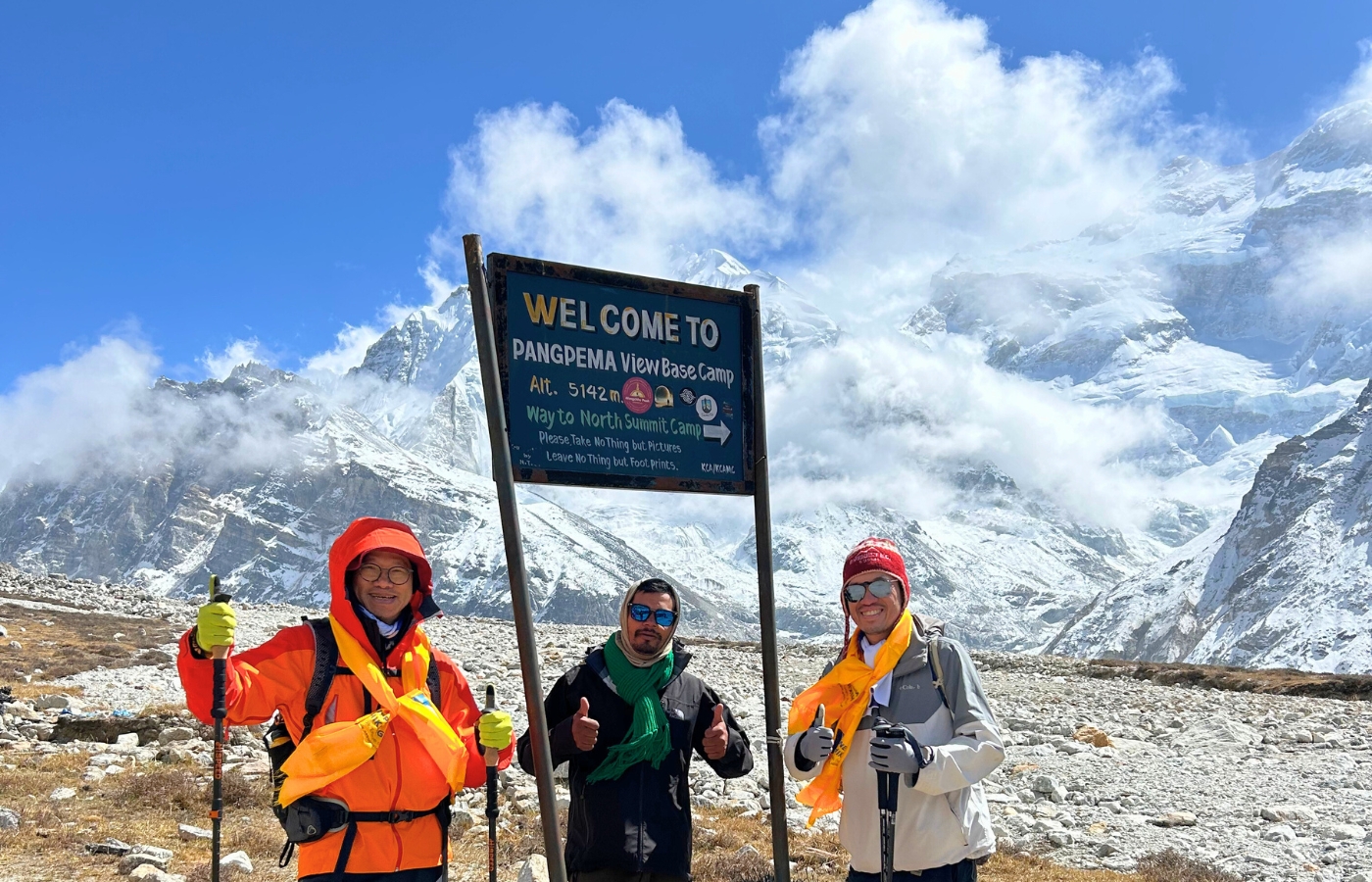
The third-highest peak in the world is Kanchenjunga, which stands at 8586 meters. This enormous peak is a testament to the splendor of nature and is tucked away between Nepal and the Indian state of Sikkim.
Kanchenjunga is surrounded by charm, glitz, and mystery, frequently overlooked by the climbers. As snow legends cling to the top of Kanchenjunga, they think nobody should stand atop Kanchenjunga. Doing so would anger the gods. As a result, climbers spend a brief time at the base camp of the third-highest peak, learn about its history, and then return with a suitcase full of memories.
Notable Features of Kanchenjunga
- Sacred to the Locals: The Sikkimese people consider Kanchenjunga sacred. It is revered as the Five Treasures of Snow, and its five peaks stand for grain holy books, gold, silver, and gems.
- Respectful Climbing: Kanchenjunga is one of the few peaks where spiritual respect triumphs over the desire for conquest because climbers customarily stop short of the actual summit out of respect for local beliefs.
- Hidden Beauty: Fewer climbers visit Kanchenjunga as it is less visible, thus making it a less frequent trekking destination. However, travelers are attracted to this isolated mountain peak for an unspoiled experience in the Himalayan wilderness.
- The Kanchenjunga Base Camp: The Kanchenjunga Base Camp Trek is a breathtaking journey that takes hikers to the north and south base camps. This incredible trekking journey offers a close-up look at the mountain's beauty and is the thrill of a lifetime.
Lhotse (8,516 meters)- The Fourth Highest Peak
MT. Lhotse is connected to Everest by the South Col. Climbers who attempt Everest frequently ascend the Lhotse to acclimate. After Everest K2 and Kanchenjunga Lhotse, also known as Lhotse, is the fourth-highest mountain in the world, standing at 8516 meters. The typical path to Everest begins on the northwest flank of Lhotse before crossing to the more well-known peak. Lhotse is a popular challenge for mountaineers because it is close to Mount Everest and shares a similar path until a certain point.
Striking features of Lhotse
- Everest's Neighbor: Lhotse is the neighbor of Mount Everest, and because of this, climbers frequently attempt both peaks in a single expedition. Until they arrive at Camp 3, climbers follow the same route as Everest to reach Lhotse, diverting to the Reiss couloir on the Lhotse face to reach the peak.
- Visually Striking: Because of its sharp ridges and eye-catching pyramid shape, many think Lhotse is more aesthetically pleasing than Mount Everest in Nepal. Lhotse is much less crowded even though it is close to the highest peak in the world.
- Historic Ascent: The 1956 ascent of the Lhotse main summit marked a significant turning point in mountaineering. Two pioneers in mountaineering, Fritz Luchsinger and Ernst Reiss, accomplished it.
Makalu (8,481 meters)- The Fifth Highest Challenge
Makalu, the fifth-highest mountain in the world at 8481 meters, is renowned for its difficult climbing and is considered one of the world's most revered eight-thousands. It rises in the Mahalangur Himalayas, straddling the border between China and Nepal just less than 20 kilometers southeast of Mount Everest.
Characteristics of Mount Makalu
- Origin of the name "Makalu: Makalu" is derived from the Sanskrit phrase Maha Kala, which means Big Black and refers to the Hindu God Shiva. This association gives the mountain a sense of mystery while emphasizing its holiness and cultural diversity.
- Pyramid of Steepness: Across the Nepal-Tibet border, Makalu is a perfect four-sided steep pyramid that attracts mountaineers from around the globe.
- French Conquest: In 1955, a French expedition led by Jean Franco became the first to summit Makalu, marking a significant achievement in mountaineering history.
- Off-the-beaten path: Makalu region is one of Nepal's lesser-known trekking destinations because of its challenging routes and rugged terrain that appeal to trekkers seeking a more daring, less crowded experience.
Cho Oyu (8,188 meters)- The Turquoise Goddess
Cho Oyu, also referred to as the Turquoise Goddess in Tibetan mythology, is the sixth-highest mountain in the world and the fifth-highest in Nepal, rising to a height of 8188 meters (26864 feet). Cho Oyu in the Khumbu sub-section of the Mahalangur Himalayas is only 20 kilometers west of Mount Everest and has many unique features.
The Nangpa La trade route, which is a few kilometers to the west and connects the Khumbu region to the Tibetan Plateau and Sherpa communities to Tibetan traders and herders, acts as a hub for trade and culture.
Notable attributes of Cho Oyu.
- Turquoise Goddess: The Tibetan name Cho Oyu, which translates to Turquoise Goddess, is a fitting name for a beautiful and elegant mountain. It remains one of the Himalayas' most intriguing and accessible summits.
- The Gentle Giant: Cho Oyu is thought to be the most climbable of the world's 8000-meter peaks. Because of its softer slopes and relatively easier ascent, it is a sought-after challenge for people looking to test their high-altitude capabilities.
- Trading Route: Accessibility is a key factor differentiating Cho Oyu from other 8000-meter peaks. The nearby Nangpa La Pass connects the Tibetan and Khumbu Sherpa communities, highlighting the mountain's historical and cultural importance.
Dhaulagiri I (8,167 meters)- The White Mountain
Dhaulagiri I, the seventh highest peak in the world, known as the White Mountain, rises to 8167 meters, a significant challenge for climbers. Situated in western Nepal, it features many unique characteristics. The name Dhaulagiri is derived from the Sanskrit words "Dhawala," meaning dazzling white and beautiful, and "Giri," which means mountain.
Key Characteristics of Dhaulagiri I.
- The White Mountain: Dhaulagiri I is well-known for being the White Mountain because of its snow-capped slopes and imposing height. Its beauty is further enhanced by its location just 34 kilometers from Annapurna I along the well-known Annapurna Circuit trek.
- First Ascent: A famous ascent immortalized its name in mountaineering legend on May 13, 1960. Diemberger Kurt A. Schelbert E. Forrer was the first to stand atop its 8167-meter summit, followed by Sherpa climbers Nawang Dorje and Nyima Dorje.
- Kali Gandaki Gorge: The Gorge, recognized as the world's deepest gorge, separates the Annapurna massif from Dhaulagiri I and dramatically shapes the local landscape.
- Rain Shadow Effect: The main feature is semi-desert-like places like Mustang and Dolpo in the Dhaulagiri mountain range. These specific climatic traits are what give Nepal its diverse landscapes.
- Dhaulagiri Circuit Trek: The Dhaulagiri Circuit Trek is one of Nepal's most well-liked trekking routes. This hike perfectly captures the area's natural beauty and varied terrain.
Mount Manaslu (8,163 meters)- The Mountain of the Spirit
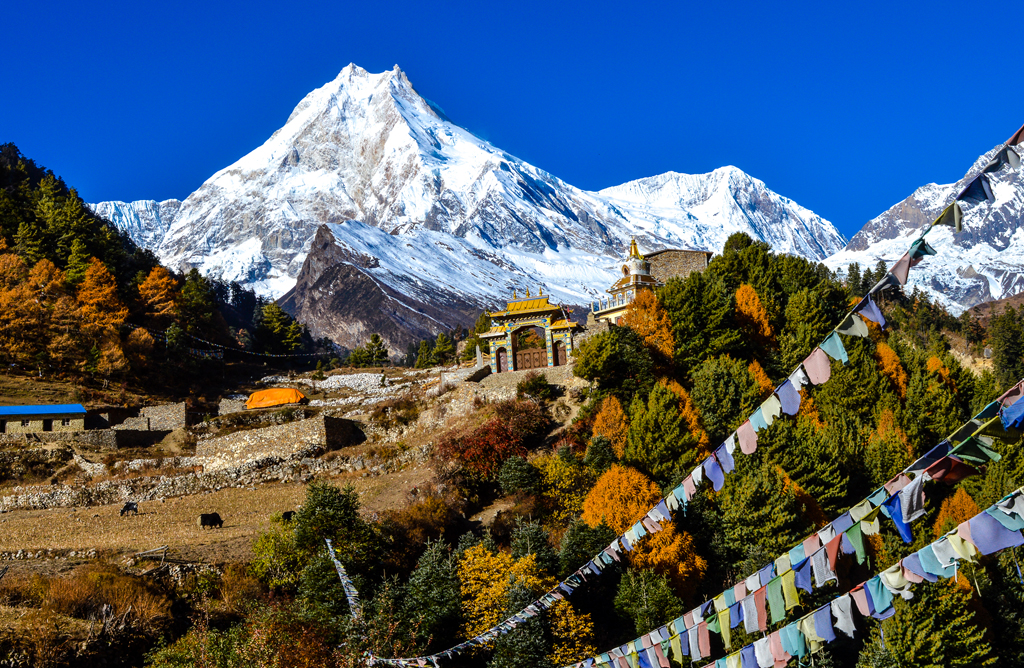
Mount Manaslu, the Mountain of the Spirit, is 8163 meters high and the world's eighth-highest peak. The name originates from the Sanskrit word "Manasa," meaning intellect or soul, and its place in the Mansiri Himal adds deep spiritual significance.
Notable features of Mount Manaslu
- Japanese Mountain: Mount Manaslu is commonly called a Japanese mountain because of its association with Japanese mountain climbers. The numerous unsuccessful and successful Japanese expeditions that visited the peak are the source of its nickname.
- The Killer Mountain: Mount Manaslu is called the Killer Mountain because of the threat of high-altitude sickness and the frequent icefall that poses several obstacles for climbers who dare to ascend this formidable peak.
- Trekking Treasures: The Manaslu Conservation Area, part of the Manaslu region, is home to breathtaking trekking routes such as the Tsum Valley Trek and the Manaslu Circuit Trek. These treks have spectacular views of Mount Manaslu and the surrounding area.
Annapurna I (8,091 meters)- The Goddess of the Harvest
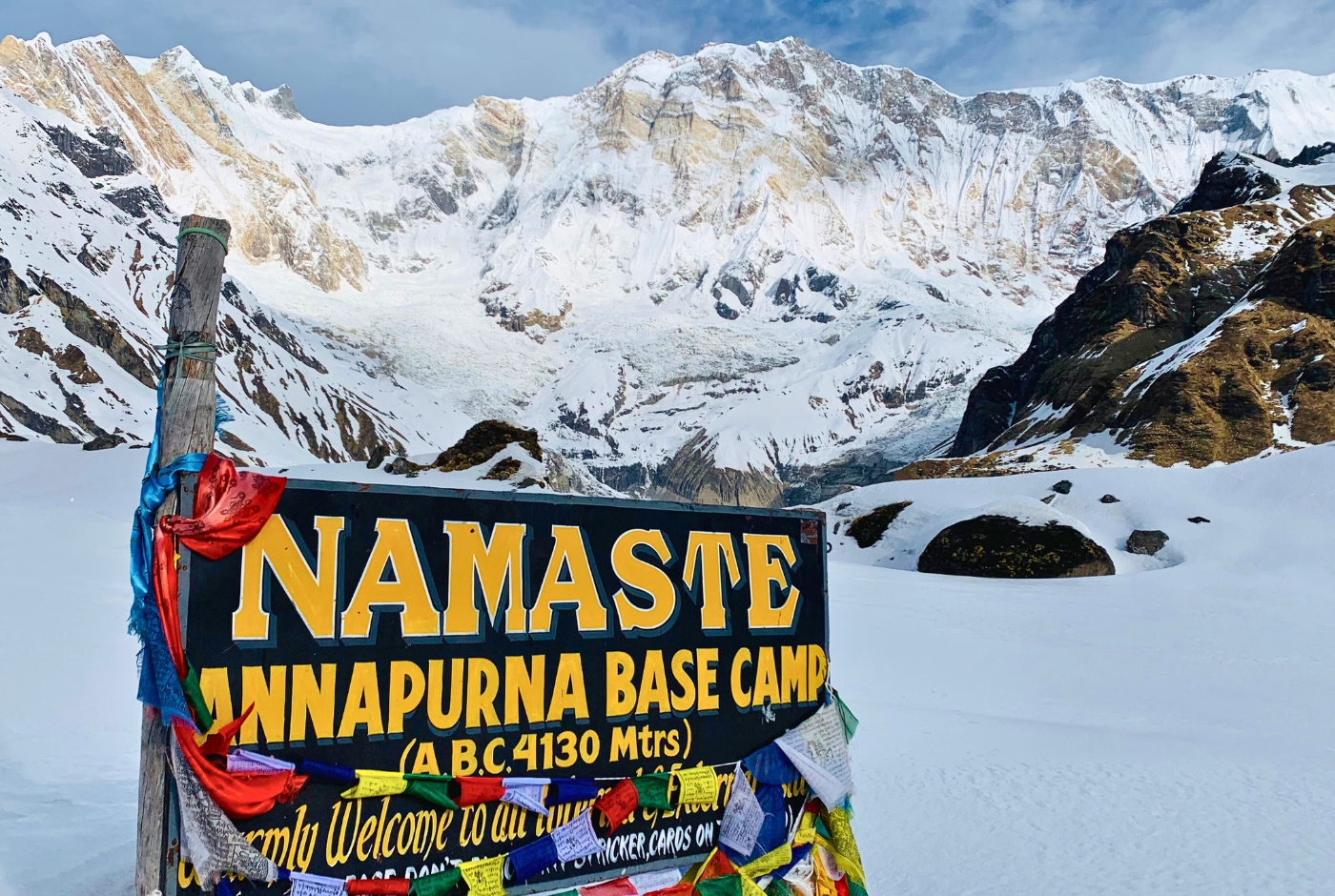
With a height of 8091 meters, Annapurna I is Nepal's eighth-highest mountain peak and the world's tenth-highest mountain. It is a well-liked Himalayan symbol of Nepal. In Sanskrit, the name 'Annapurna' stands for abundance and sustenance, and this mountain is named after the Hindu goddess of food and grains.
Key attributes of Annapurna I.
- Goddess of Abundance: The Sanskrit terms Anna, which means food, and Purna, which means whole or complete, is the origin of Annapurna. It illustrates how the mountain feeds the land.
- Historical Triumph: Under the leadership of Maurice Herzog and Louis Lachenal, the French expedition successfully became the first to climb Annapurna I in 1950. Since it was the first successful ascent of an 8000-meter peak, it represented a significant milestone.
- Difficult Ascent: Annapurna I is known for being extremely dangerous and challenging to climb because climbers have to deal with perilous terrain avalanches and erratic weather.
- Trekking Gems: The Annapurna region is well-known for its stunning trekking routes and majestic peaks, especially during the Annapurna Sanctuary and Annapurna Base Camp treks.
Gyachung Kang (7,952 meters)- The Enigmatic Peak
The ninth-highest mountain in Nepal and the fifteenth-highest in the world, Gyachung Kang, rises to 7952 meters. Nestled between the well-known Mount Everest and Cho Oyu, this mountain, which is frequently obscured, has a distinct charm.
Key Aspects of Gyachung Kang
- Undiscovered Beauty: Frequently eclipsed by its imposing neighbors Everest and Cho Oyu Gyachung Kang, it is still a mysterious and little-visited peak. Its anonymity gives it a sense of mystery and isolation.
- Reputable Trekking Trails: Some of Nepal's most well-known trekking routes are near Gyachung Kang. While hiking well-known routes like the Everest Base Camp Trek, Gokyo Lakes Trek, and Three Passes Trek, trekkers can take in breathtaking views of this peak.
- Testament of Natural Beauty: The pristine natural beauty of the Himalayas is demonstrated by Gyachung Kang's surroundings, which allow climbers to enjoy the breathtaking views and untouched wilderness.
Annapurna II (7,937 meters)
With a height of 7937 meters, Annapurna II is a notable mountain in Nepal Annapurna Massif. Though it may be overshadowed by its renowned and legendary sibling Annapurna I, this mountain, the 16th highest in the world and the 10th tallest peak in Nepal, has its distinct personality and charm.
Key Characteristics of Annapurna II.
- Mountain Sibling: The Annapurna Massif, which contains the powerful Annapurna I, is home to Annapurna II, making them a mountain sibling. Mountaineers and hikers alike are enthralled by the mountain siblings' stunning mountainous landscape.
- Scenic Beauty: Annapurna II has an impressive visual appeal despite not being as high as its sibling. Trekkers and climbers find it a picturesque sight due to its remarkable pyramid shape and immaculate slopes.
- Trekking Pleasures: Annapurna II is part of the Annapurna region's well-known trekking routes. Trekkers get the privilege of experiencing this mountain beauty through thrilling treks like the Annapurna Circuit and Annapurna Base Camp.
- Remote Wilderness: Annapurna II provides visitors with a sense of solitude and tranquility amidst pristine wilderness because it is located in an area of the Himalayas that has seen comparatively little travel.
Faqs - Your Questions, Answered
How many mountains are the highest in Nepal?
Eight of the world's fourteen highest mountains, rising and soaring above 8000 meters, are proudly found in Nepal, a country shrouded in the Himalayas' mystery, majesty, and enigma.
What is the number of mountains in Nepal?
Over 1310 breathtaking peaks that are higher than 6000 meters above sea level have been identified in Nepal. NMA, one of the Nepal Mountaineering Associations, has authorized 326 peaks for climbing and trekking. Furthermore, all adventurers are welcome to ascend Nepal's more than 300 Himalayan peaks, subject to government regulations.
What proportion of Nepal is made up of rocky hills and mountains?
The flat plains of the Terai region make up only about 25% of the country's land, with the remaining 75% of it made up of mountains and rough hills.
Is K2 or Kanchenjunga the highest?
K2 Peak, which is 8611 meters high, is regarded as the second-highest mountain in the world. The Karakoram range, which separates China and Pakistan, is savagely and violently towering. Its distinctively untamed slope, merciless storms, and treacherous climbs give it the name or container of Savage Mountain.
Kanchenjunga is 8586 meters high and lies on the border between Sikkim and Nepal. Meanwhile, the Main South and Central peaks are on the border. Kanchenjunga West is located in the Taplejung District of Nepal. It is one of Nepal's eight-thousand mountains and the third-highest mountain peak in the world.
Is Mount Everest located in China or Nepal?
Mount Everest is situated near the Nepal-China border in the Himalayas. Everest's northern half is in Tibet (Qomolangma Zone), while the southern half is in Nepal (Sagarmatha Zone). Here are the precise coordinates and Everest location.
- Latitude: 27.9881° N.
- Longitude:86.9250° E
Is Annapurna higher than Everest?
The formidable Mount Everest is taller than Annapurna. Ascending to an astounding 8848. 86 Everest, a king among mountains, appears to be kissed by the heavens with its top garland in clouds. Even though Annapurna is a legendary mountain in Nepal, its grandeur is overshadowed by Everest as it rises to a modest 8091 meters (26545 feet).
Why is Nepal called "The Land of the Himalayas is Nepal"?
Mount Everest and other high peaks in the world can be found in Nepal, known as the Land of the Himalayas, due to its location in the center of the Himalayan Mountain range. Nepal earned its nickname for its geographic location, stunning landscapes, cultural significance, and adventure travel options.
What is the deadliest of Nepal's ten highest mountains, and why is it so dangerous?
Annapurna I is the deadliest of Nepal's ten highest mountains and the most dangerous Himalayan peaks. Climbers trying to reach the summit of Annapurna often die because of the mountain's rugged terrain, avalanche-prone slopes, and erratic weather.
What are well-known hikes and expeditions near the world's ten highest mountains?
These are a few well-known hikes and expeditions near the world's ten highest mountains.
1. Nepals Mount Everest(Nepal/ Tibet):
- Mount Everest Base Camp Trek: This well-liked trek among climbers offers outstanding scenic views of the Himalayan peaks and leads to the most fantastic base camp, the Everest Base Camp.
- The Everest Expedition: The Everest Expedition is the ultimate challenge for mountaineers who want to reach the top of Nepal, the world's tallest mountain.
2. K2: China/Pakistan.
- K2 Base Camp Trek: This trek is a challenging hike that ends at the base camp of K2, the second-tallest mountain in the world.
- K2 Expedition: The K2 Expedition is a challenging and demanding climb frequently thought of as more technically demanding than Everest.
3. Kanchenjunga (India/Nepal)
Trek to Kanchenjunga Base Camp: This isolated, less-visited route provides stunning views of the Kanchenjunga and neighboring peaks.
4. Lhotse(Tibet/Nepal):
Lhotse Expedition: Lhotse shares a portion of its route with Everest Everest climbers who frequently go on expeditions.
5. Makalu(Nepal/Tibet)
Makalu Base Camp Trek: This hike offers views of one of the highest peaks in the world and takes you to Makalu Base Camp.
6. Oyu Cho (Tibet/Nepal)
Cho Oyu Expedition: Climbers looking for high-altitude experience are drawn to this 8000-meter peak because it is less technically demanding.
7. Dhaulagiri (Nepal)
Trekking the Dhaulagiri Circuit: This strenuous journey circles the Dhaulagiri mountain range, renowned for its untamed and isolated landscape.
8. Manaslu (Nepal)
Manaslu Circuit Trek: This trek offers a blend of natural beauty and culture as it circles the eighth-highest mountain in the world.
9. Nanga Parbat ( Pakistan)
Nanga Parbat Expedition: Nanga Parbat of Pakistan, popularly known as the Killer Mountain, is among the deadliest to ascend, offering several routes for climbers.
10. Annapurna (Nepal)
- Trekking the Annapurna Circuit: This traditional trek travels around the Annapurna massif, passing through cultural villages and various landscapes.
- Trek to Annapurna Base Camp: This shorter hike takes you to the Annapurna Base Camp, which is encircled by some of the highest peaks in the world.
What does the mountaineering 8000-meter club mean?
The 8000-meter club comprises climbers who have completed all 14 of the 8000-meter peaks in the world. With so many of these peaks, Nepal is a popular destination for mountaineers hoping to become members of this exclusive group.
Among the 8000-meter peaks, is Mount Everest the most dangerous?
Of all the 8000-meter peaks, Mount Everest is not necessarily the most dangerous despite being undoubtedly tricky. Mountains like K2 and Annapurna I are frequently regarded as riskier because of their higher fatality rates and technical challenges.
Are there any limitations on climbing these Nepalese mountains?
In Nepal, climbing permits are necessary for all expeditions, and the cost varies according to the location and height of the mountain. Additionally, climbers must honor cultural and religious restrictions on some mountains, such as Kangchenjunga.
When is the best time of year to trek and climb in the mountains of Nepal?
In Nepal, the pre-monsoon (spring) and post-monsoon (autumn) seasons are ideal for trekking and climbing because of the breathtaking scenery and generally stable weather.
Does climbing the highest mountains have any age restrictions?
There are no age restrictions for climbers to survive the harsh conditions and difficulties of high-altitude climbing, although climbers must be mentally and physically prepared.
Why is there a Death Zone on these well-known mountains?
Elevations over 8000 meters are referred to as the Death Zone because of the extremely low oxygen and air pressure, which can cause severe altitude sickness and eventually death. Climbers need to spend as little time in this area as possible.
Big Mountain: What is the biggest Mountain in the Nepal?
In Nepal, the "big mountain" most likely refers to Mount Everest, the world's highest peak. It's located on the border between Nepal and China. Other high mountains in the region, also part of the Himalayas, include K2 (which is the world's second highest mountain) and Kangchenjunga.
Final Words
In conclusion, the mountains of Nepal are impressive. While there are many incredible peaks in this Himalayan region, Mount Everest is undoubtedly a star. Nepal is home to the eight highest mountains in the world and has seen ten of the world's highest peaks. There is a fascinating story to be told about every mountain peak, one where the wonders of nature meet human curiosity and bravery. The adventure perfectly encapsulates the spirit of the Himalayas.

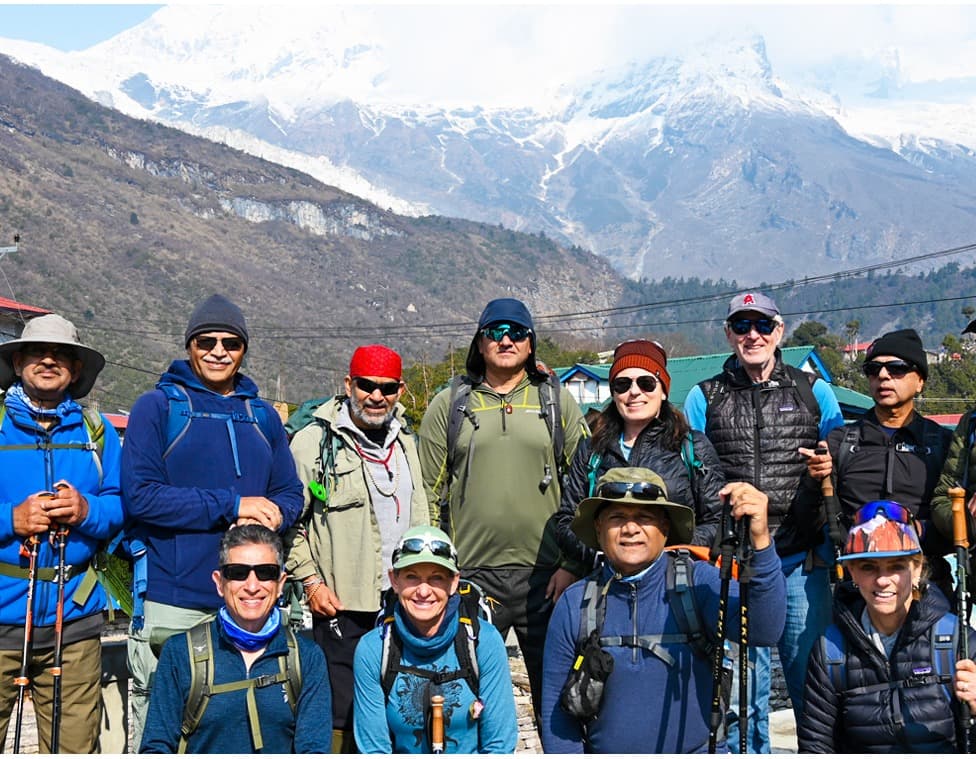

Post a Comment